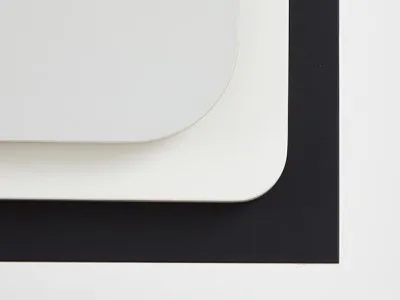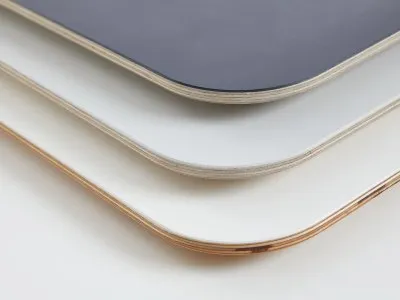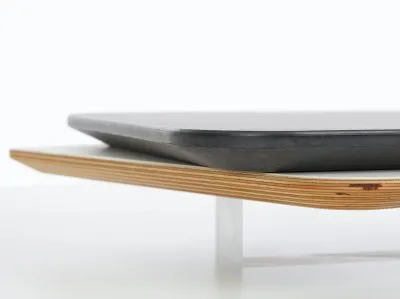In addition to a classic straight edge, the bevelled edge at an angle of 25° makes an HPL tabletop appear significantly thinner, almost floating, despite its stability, because only approx. 8 mm of material remains as the visible edge of the tabletop. The filigree appearance is supported by the softly rounded corners with a radius of 25 mm or better 50 mm. They also ensure that bruises are not too bad if active kids bump into the HPL tabletop.
Send configuration
Design your HPL table top, klick "Save" and send your draft to your email. Finalize it whenever you want.
We are here for you
If you have any questions about specific configurations or materials, please feel free to contact us via our chat.
Properties of the HPL table top
Maximum dimension
HPL table top with MDF or multiplex core
240 x 120 cm
Table top core
Birch multiplex or MDF (anthracite), sanded
Thickness
HPL table top with MDF core
20 mm
HPL table top with multiplex core
19 mm or 25 mm
Corner radius
3 mm, 25 mm or 50 mm
Cable aperture
Distance between tabletop edge and centre of cable aperture
min. 13 cm
HPL (High Pressure Laminate) consists of cellulose fibre sheets impregnated with phenolic resin and a top layer of colouring cellulose fibre sheets impregnated with melamine resin. These are pressed together at high temperatures under high pressure to form a dense laminate and then pressed together with the multiplex or MDF board for our table tops. Very thin CPL (Continuous Pressure Laminate) is used as a backing on the underside. The process described above creates the tabletop's extremely resistant and easy-care surface. The closed, non-porous surface is easy to clean and does not provide a breeding ground for micro-organisms.
The cut edges of a birch multiplex plywood panel can never show a flawless striped appearance due to the production process. During the production of the plywood panel, several layers of birch veneer are glued crosswise on top of each other. During this process, there are always small overlaps or gaps between the veneer sheets, which can appear in the cut edge of your tabletop. Our carpenter closes small holes with suitable wood filler so that no moisture can penetrate the tabletop in the affected areas.
When it comes to cleaning and caring for HPL tabletops, there is hardly any difference to melamine versions. The best way to clean the surface is with a damp cloth and gentle cleaning agents. Although the closed surface is very resistant, certain cleaning utensils should not come into contact with it. Scratching sponges, pot cleaners and similar all-rounders leave obvious marks and attack the surface of the tabletop. It is better to use speed to remove grease stains from the HPL tabletop, for example.
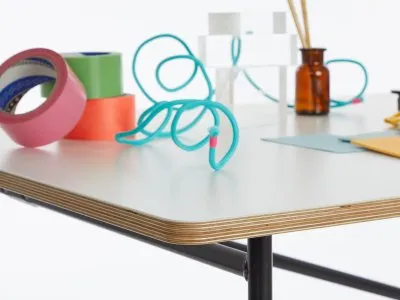
HPL tabletop for (almost) everything
Due to its robust properties, the HPL tabletop is not only a solid desk top, but also bravely endures everyday use as a dining tabletop with spilled liquids, sticky children's hands and wild dice games. And for all its practicality, the sleek matte tabletop looks light and elegant with a choice of straight or angled edges and rounded corners.
Important: Even though our table tops made of HPL are extremely robust, they unfortunately do not have weather-resistant properties. For this reason, they are not suitable for use as garden tables outdoors.
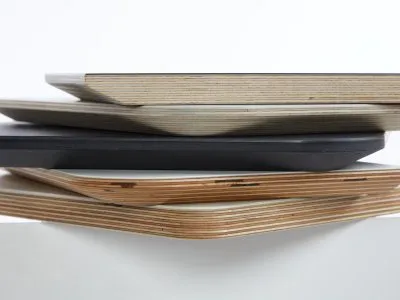
Colours, corner radii and tabletop cores: individually customisable
The customised HPL tabletop is available in classic, soft and bright colours. Each colour can be freely combined with the two board cores. You can choose a birch multiplex board core or an MDF board core in anthracite. This allows you to create light, friendly or subdued, dark combinations, but also - if you are looking for a contradiction - contrasting effects. And that's not all: the four corners of the tabletop give you even more room for manoeuvre. These can have a classic radius of 3 mm or be more rounded (25 mm or 50 mm). In this way, you can make your HPL tabletop look delicate and light in combination with a slanted edge.
